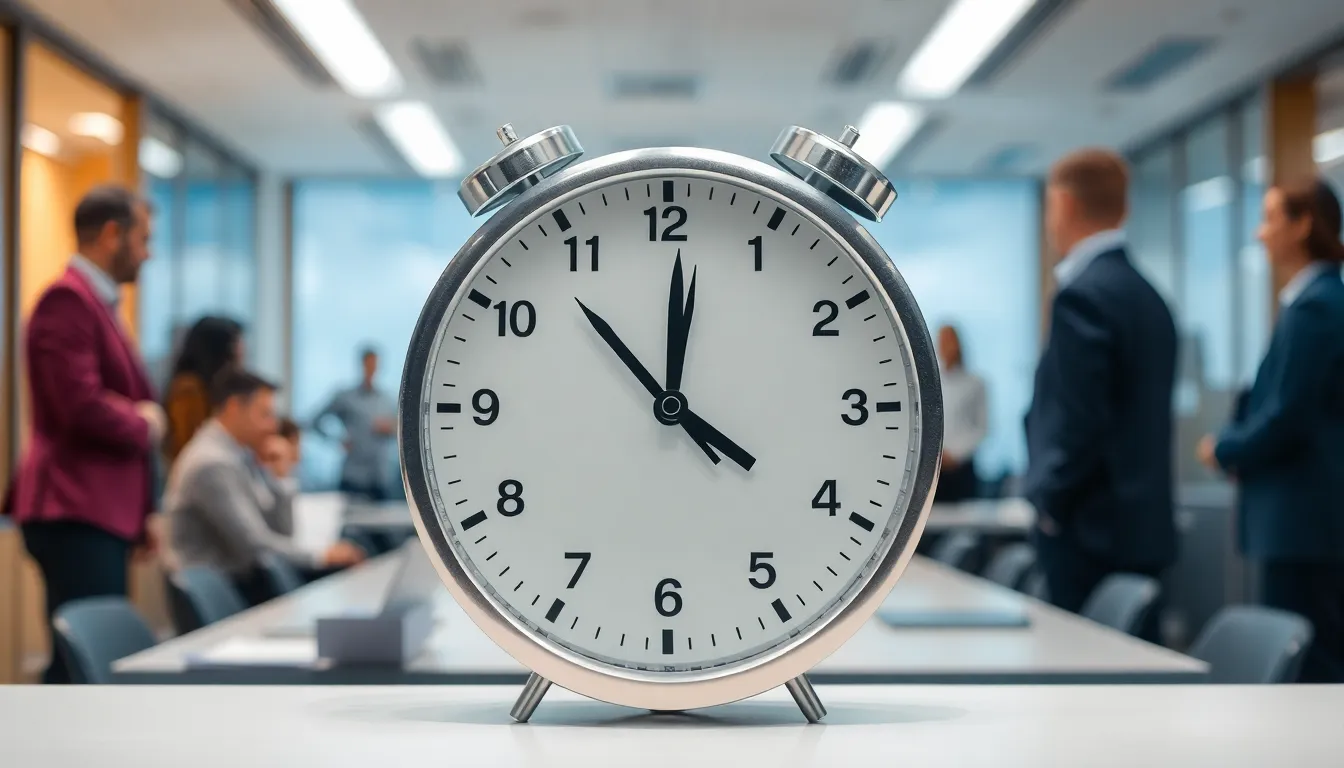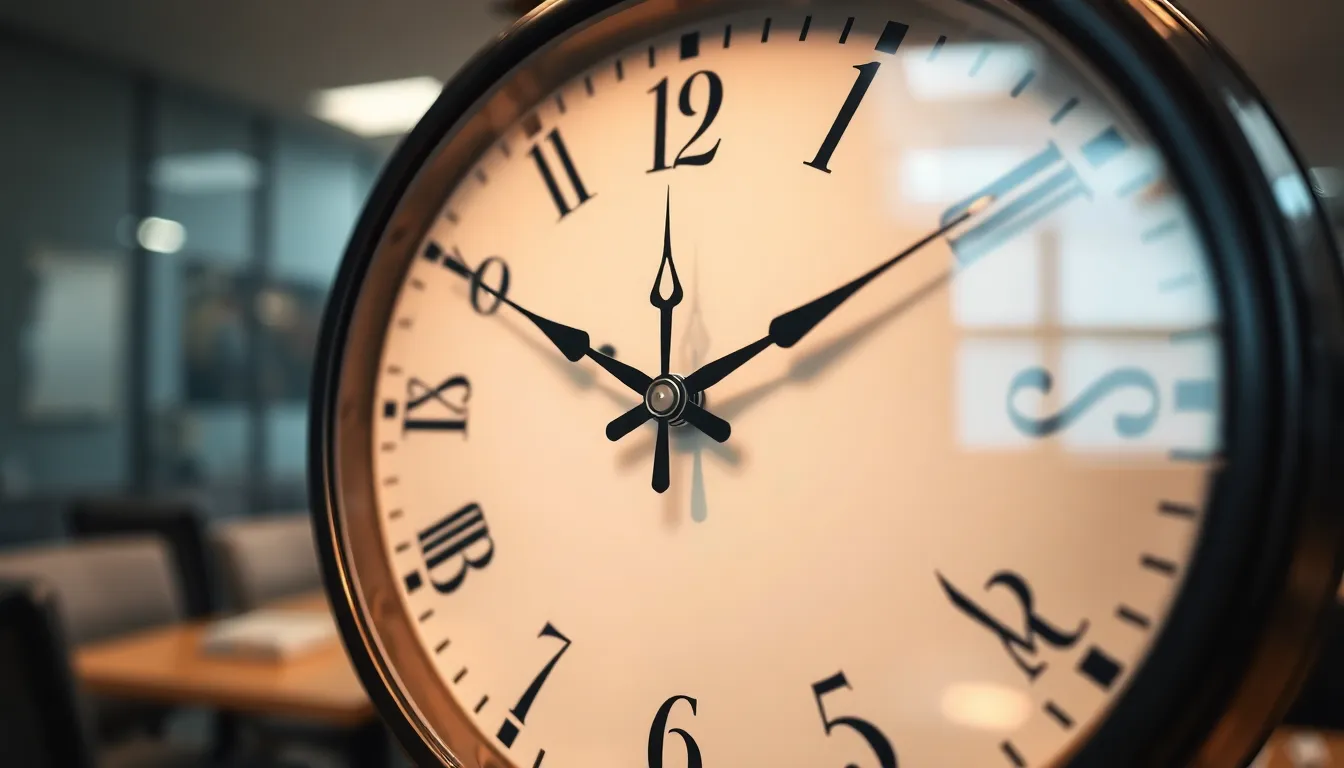Table of Contents
ToggleTime can be a tricky beast. One moment it’s 2:15 and you’re feeling like a productivity ninja, and the next, you’re frantically calculating how many minutes until 3:20. Whether it’s for that all-important meeting or a well-deserved coffee break, knowing the countdown can save the day—or at least keep you from showing up fashionably late.
Understanding Time Calculation
Calculating the minutes until a specific time requires basic arithmetic. To determine how many minutes remain until 3:20, one needs to know the current time first. For example, if the current time is 2:50, the calculation involves finding the difference between the two times.
Subtracting the current hour from the target hour gives one a clear basis for calculation. In the previous example, from 2:50 to 3:00 is ten minutes. Then, add the additional 20 minutes to reach 3:20. This results in a total of 30 minutes until 3:20.
Another important aspect involves understanding the 12-hour clock format. If it’s currently 1:45, the calculation shifts slightly from earlier examples. First, it’s necessary to recognize that moving from 1:45 to 2:00 takes 15 minutes. Then add the full 60 minutes from 2:00 to 3:00, and finally add 20 more minutes to 3:20. The final count totals 95 minutes in this scenario.
One can also apply this method for hours later in the day. If it’s currently 5:50 and one seeks to know how many minutes until 3:20 the next day, the calculation changes. Start by counting the remaining 10 minutes to 6:00. From there, the full hours until midnight require 18 hours or 1,080 minutes. Lastly, include the 200 minutes until 3:20 the next day. Adding them all gives a total of 1,290 minutes until 3:20.
Using visual aids or time conversion apps can provide clarity. They enable quick calculations, making time management much simpler for busy schedules.
Breaking Down the Query

Understanding how to calculate the minutes until a specific time enhances daily productivity. Knowing time helps prioritize tasks and manage schedules effectively.
Importance of Knowing Time
Awareness of time can significantly impact productivity. Recognizing deadlines instills a sense of urgency in tasks. In professional environments, for instance, knowing the remaining minutes until meetings allows individuals to prepare adequately. Personal life also benefits from time awareness; it facilitates better planning for events and appointments. Maintaining punctuality fosters professionalism and shows respect for others’ time. A simple glance at the clock can prevent unnecessary stress and last-minute rushes.
Contexts for Time Calculation
Time calculations apply in various situations. Daily activities often require timing, whether it’s scheduling breaks, planning meals, or coordinating with others. For example, during a workday, knowing how many minutes are left until 3:20 informs when to wrap up tasks. Transportation schedules are another context; using time calculations ensures timely arrivals at buses or trains. In social settings, confirming time before outings ensures coordination among friends. Each context reinforces the need for effective time management, showcasing its relevance in both professional and personal scenarios.
How to Calculate Minutes
Calculating minutes until a specific time can simplify time management and improve productivity. Different methods exist to make this task straightforward.
Simple Subtraction Method
Subtraction serves as the easiest way to calculate minutes until 3:20. First, convert the current time into minutes since midnight. For example, if the current time is 2:45 PM, convert it to 845 minutes (2 hours × 60 minutes + 45 minutes). Next, determine the target time in minutes, which is 200 minutes for 3:20 PM. Finally, subtract the current time from the target time: 200 minutes minus 845 minutes results in 35 minutes left until 3:20. This simple arithmetic method highlights the importance of knowing how to perform time calculations effectively.
Using a Clock for Visualization
Using a clock can provide a visual representation of time until 3:20. Start by noting the current hour and minute on the clock. For instance, if it’s 2:45, count the number of minute markers between the current time and the target time. Each minute marker represents one minute, enabling a clear overview of how many minutes remain until 3:20. This method offers a visual cue that aids in grasping time concepts better, fostering a sense of urgency for approaching deadlines or events. By frequently practicing this technique, individuals can enhance their understanding of time management in various situations.
Practical Applications
Understanding time calculations proves essential in daily life. Many individuals encounter moments when they need to track minutes until a specific hour.
Everyday Scenarios
Scheduling meetings effectively often relies on time awareness. For example, knowing how many minutes remain until 3:20 can help avoid rushing. People frequently encounter this need at work or during appointments. Passing deadlines can lead to stress, so estimating the time left proves beneficial. A simple way to apply this knowledge involves setting timers to stay on track. Effective use of clocks and reminders fosters punctuality.
Time Management Tips
Enhancing time management skills requires practical methods. Begin by practicing subtraction for quick calculations. Familiarize oneself with the current time to determine the minutes until a target hour like 3:20. Visual aids, such as clocks, act as helpful reminders about approaching deadlines. Setting specific goals can prioritize tasks effectively based on remaining time. Breaks or tasks that align with time estimates can boost productivity. Ultimately, mastery of time calculations leads to better organization and improved efficiency in life.
Mastering time calculations is essential for effective time management. By understanding how to determine the minutes until a specific hour like 3:20 PM individuals can enhance their productivity and avoid unnecessary stress. Staying aware of the time helps prioritize tasks and maintain a structured schedule.
Utilizing tools such as timers or visual aids can further support this effort. With practice and the right techniques anyone can improve their punctuality and organization. Embracing these time management strategies ultimately leads to a more efficient and balanced life.




